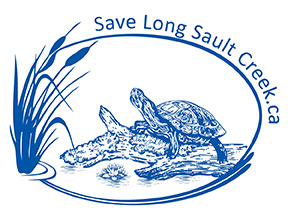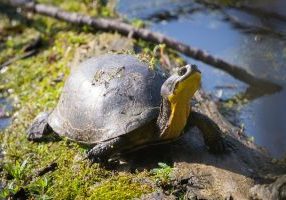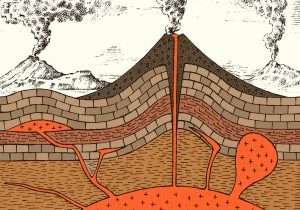Human Impact on Blanding’s Turtles
A friend recently sent me the summary of a research paper titled “Archival data reveals human impacts on Blanding’s turtle populations persistence,” which was recently published in the Journal of Nature Conservation. There are many interesting findings in this paper that relate to citizen concerns about this species of turtles living along Highland Line in and near the area where Thomas Cavanagh Construction Ltd is proposing to build a large scale aggregate extraction gravel pit.
Like most if not all the seven species of turtles in Ontario, the Blanding’s turtle is threatened by the loss of their habitat through ever expanding human development and by roadside mortality. What is crucial to this particular species is the fact that they need to travel overland far from one wetland to another in search of a mate and or to make a nest and lay their eggs.
The Ontario government Blanding’s turtle website (www.ontario.ca/page/blandings-turtle-general-habitat-description) specifies that these turtles live in shallow water, usually in wetlands or shallow lakes. Yet they are commonly found hundreds of meters away from water. Their nests are in open fields, along shorelines and beaches, on road shoulders and gravel roads, and in gardens and old railway beds. The females often go back to the same nesting sites year over year. Similarly, Blanding’s turtles overwinter on the same sites they have used in previous years, usually in wetlands or a wetland complex, which is defined as wetlands within 500 meters of each other.
One study in the Parry Sound-Bancroft district tracked these turtles travelling as far as 2.3 kilometers. Another study in Minnesota found the range of movement of these turtles to be 1.6 kilometers with a maximum range of just over 5 kilometers.
The wetlands adjacent to the north and south branches of Long Sault Creek are home to many Blanding’s turtles. Construction of massive gravel pits as proposed by Cavanagh along the south branch of this creek will severely disrupt their patterns of movement. Right now they can wander from one wetland and bog to another in that area. The company is proposing to construct turtle fences as a remedy. These fences will go around the entire excavation site and severely impact these turtles’ mobility. They are wanderers and their annual pilgrimage throughout the region will be restricted. No matter which way you look at it, the proposed pit will be a major stumbling block to their survival in this area.
Photo of Blanding Turtle By Andrew C - Blanding's turtle (Emydoidea blandingii), CC BY 2.0
Other Articles & Updates
Human Impact on Blanding’s Turtles
Like most if not all the seven species of turtles in Ontario, the Blanding’s turtle is threatened by the loss of their habitat through ever expanding human development and by roadside mortality.
Read MoreBald Eagles Near and Far
A couple of weeks ago, I was getting bird food at a specialty store in Kanata. The shop has its own TV screen, and on it was a livestream youtube video of a bald eagles’ nest in California…
Read MoreRock Sample Analysis Presentation by Linda Harvey
Review Linda Harvey’s presentation on the rock sample analysis.
Read More


